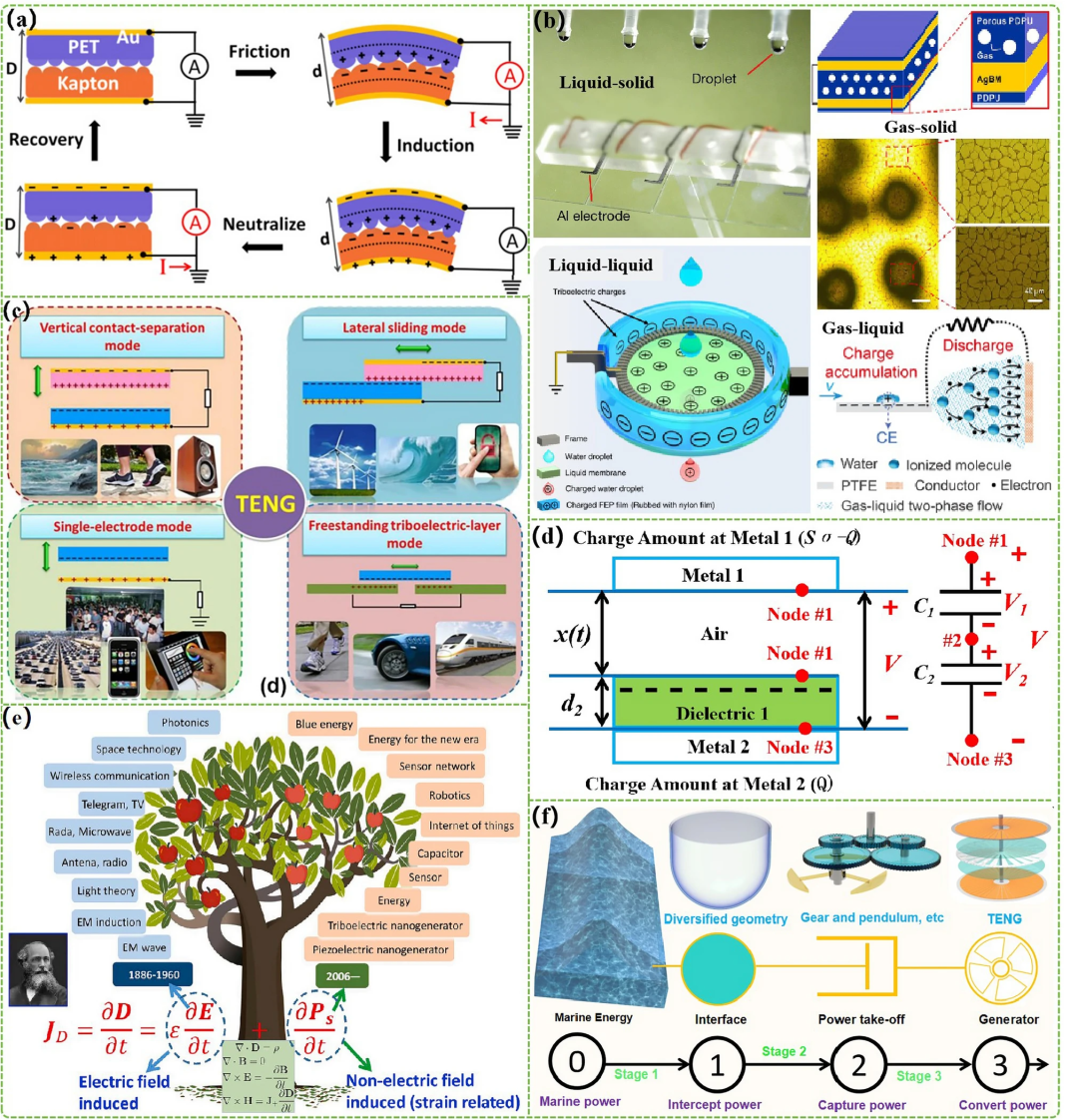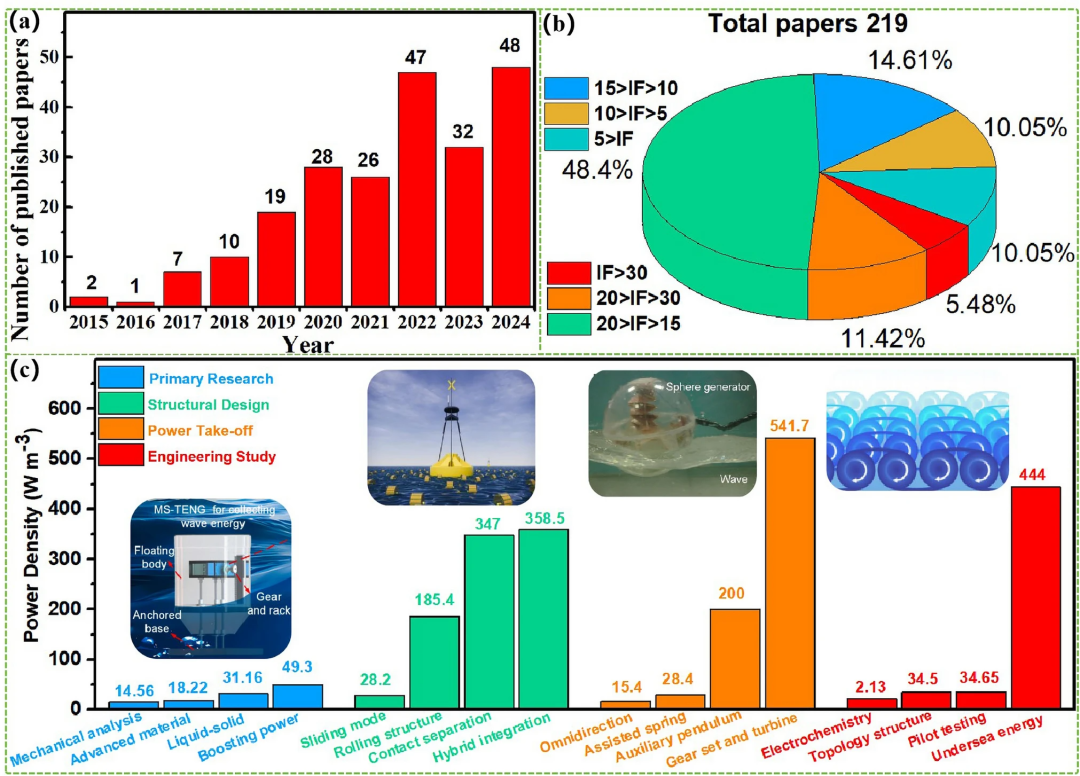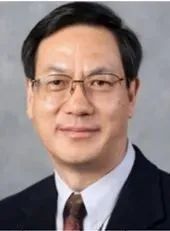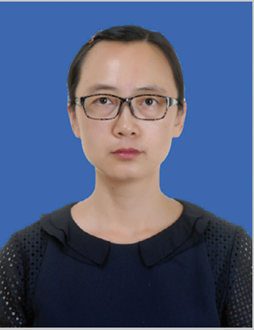Click the blue text to follow us
Research Background
The ocean harbors abundant renewable energy, making it one of the most important sources for humanity to obtain large-scale green power. Among these, the annual storage of ocean wave energy exceeds 10,000 terawatt-hours, making it a significant target for the development of blue energy in the ocean. Additionally, utilizing the abundant water resources in the ocean through electrochemical methods to in-situ harness corresponding electrical energy will be an important approach to obtaining low-cost clean fuel, freshwater, and treating organic pollutants in the ocean. The triboelectric nanogenerator (TENG) technology, which relies on the principles of triboelectricity and electrostatic induction, features lightweight and low-frequency high efficiency, resulting in an ultra-high mass power density, making it highly suitable for constructing floating marine energy harvesting devices. Thanks to research in power conversion devices, new materials, and new theories, various performance metrics of marine energy harvesting TENGs have been significantly improved. Furthermore, corresponding topological integration and pilot studies of large-scale devices have played an important role in promoting commercial applications in this field. Finally, the low-cost electricity obtained from high-performance marine energy harvesting devices has also led to significant advancements in advanced self-powered marine electrochemical systems that utilize in-situ energy. Therefore, research on marine energy harvesting TENGs and corresponding in-situ self-powered electrochemical systems not only provides key technical support for the industrial application of TENGs but also offers more technical options for achieving sustainable development goals for humanity at an early stage.
 Advances in TENGs for Marine Energy Harvesting and In-situ ElectrochemistryChuguo Zhang*, Yijun Hao, Xiangqian Lu, Wei Su, Hongke Zhang, Zhong Lin Wang*, Xiuhan Li*Nano-Micro Letters (2025)17: 124
Advances in TENGs for Marine Energy Harvesting and In-situ ElectrochemistryChuguo Zhang*, Yijun Hao, Xiangqian Lu, Wei Su, Hongke Zhang, Zhong Lin Wang*, Xiuhan Li*Nano-Micro Letters (2025)17: 124
https://doi.org/10.1007/s40820-024-01640-w
Highlights of this Article
1. Provides a detailed introduction to the basic information of TENGs, the power conversion process of marine energy harvesting TENGs, and key points.
2. Offers an in-depth introduction and analysis of related research on marine energy harvesting through gradient classification.
3. This article not only summarizes the latest research progress, discoveries, and challenges in greater depth but also provides reasonable prospects for solutions to related issues and future development directions.
Content Summary
Given the rapid development of TENGs in the field of marine energy harvesting and in-situ electrochemical applications, Chuguo Zhang/Li Xiuhan from Beijing Jiaotong University and Zhong Lin Wang from the Institute of Nano Energy and Systems, Chinese Academy of Sciences have systematically and comprehensively classified and summarized the research progress of TENGs in marine energy and in-situ clean fuel production over the past decade. First, the basic information of TENGs and the power conversion process of marine energy harvesting TENGs, along with the key points involved, are introduced in detail. Additionally, related research and applications are deeply introduced and summarized through gradient classification: (1) The corresponding research work is divided into four major directions: fundamental research, structural design, power conversion, and engineering research; (ii) Based on the above classification, the corresponding research directions are further divided into eight themes: fundamental research, principle innovation, basic structure, and optimized output; (iii) Further subdivided into 16 research themes based on specific research content: advanced materials, mechanical analysis, liquid-solid structures, charge excitation, rolling structures, contact separation, sliding modes, composite integration, auxiliary springs, auxiliary pendulums, gear sets/turbines, omnidirectional designs, pilot studies, topological structures, underwater energy, and electrochemical applications. Finally, not only does it provide a deeper summary of the latest research progress, discoveries, and challenges, but it also offers rational prospects for solutions to related issues and future development directions. Therefore, it is hoped that this article will provide important research ideas and references for subsequent research in this field and contribute to accelerating the sustainable development of human green energy systems.
Illustrated Guide
I Basic Information of TENGs for Marine Energy Harvesting
TENGs generally consist of electrodes and triboelectric materials, which can be categorized into five types based on the composition of triboelectric materials: solid-solid, solid-liquid, liquid-liquid, gas-solid, and gas-liquid. Based on structural composition, they can be categorized into four structures: single electrode, sliding mode, contact separation, and independent layers (Figure 1a-c). Their basic physical models and principles are variable capacitance and Maxwell displacement current (Figure 1d-e). According to relevant research, the power transmission chain and system structure of marine energy harvesting TENGs can be simplified as shown in Figure 1f. First, the energy harvesting body that directly contacts water will intercept the power of marine energy and convert it into the power of the entire marine energy harvesting device itself. The design of advanced energy harvesting bodies is a crucial foundation for achieving efficient marine energy harvesting, primarily involving the geometric structure design of fluid mechanics. Secondly, the power take-off (PTO) device in the marine energy harvesting device will capture the corresponding power through inertia and transfer it to the TENG. The inertia power capture and energy transfer efficiency of the PTO play a critical role in the effective collection of marine energy, typically consisting of mechanical transmission components such as gears and pendulums. Finally, the TENG utilizes the power output from the PTO to generate electrical energy, thereby achieving corresponding marine energy harvesting. Research aimed at improving the output performance of TENGs through materials, structures, and charge excitation is crucial for the entire marine energy harvesting process. Therefore, enhancing the energy harvesting body’s power interception, the PTO’s power capture and output, and the TENG’s output performance, as well as the system coordination among the three, significantly impacts the research on marine energy harvesting TENGs.
 Figure 1. Basic information of TENGs for marine energy harvesting. (a) Structural diagram of TENGs. (b) Structural diagram of TENGs composed of four material states. (c) Schematic diagram of four basic modes of TENGs. (d) Capacitive model diagram of contact separation TENGs. (e) Tree development framework between Maxwell displacement current relations and TENGs. (f) Power transmission chain of marine energy harvesting TENGs.II Summary and OutlookTENGs, as an emerging technology, have developed rapidly in the field of marine energy harvesting research over the past decade, achieving many milestone research results. Relevant public data indicate that the number of related research papers is rapidly increasing (Figure 2a). Among the 218 published research works, approximately 80% were published in international top journals with an impact factor (IF) greater than 10 (Figure 2b). According to relevant statistical data, the output power density of marine energy harvesting TENGs has achieved significant breakthroughs across different research directions (Figure 2c). Based on these numerous research results, we have proposed relevant prospects for existing problems and developments in 16 research directions to better promote the development of this field.
Figure 1. Basic information of TENGs for marine energy harvesting. (a) Structural diagram of TENGs. (b) Structural diagram of TENGs composed of four material states. (c) Schematic diagram of four basic modes of TENGs. (d) Capacitive model diagram of contact separation TENGs. (e) Tree development framework between Maxwell displacement current relations and TENGs. (f) Power transmission chain of marine energy harvesting TENGs.II Summary and OutlookTENGs, as an emerging technology, have developed rapidly in the field of marine energy harvesting research over the past decade, achieving many milestone research results. Relevant public data indicate that the number of related research papers is rapidly increasing (Figure 2a). Among the 218 published research works, approximately 80% were published in international top journals with an impact factor (IF) greater than 10 (Figure 2b). According to relevant statistical data, the output power density of marine energy harvesting TENGs has achieved significant breakthroughs across different research directions (Figure 2c). Based on these numerous research results, we have proposed relevant prospects for existing problems and developments in 16 research directions to better promote the development of this field. Figure 2. Statistical analysis of research data related to marine energy harvesting TENGs. (a) Statistical chart of the number of papers published annually on marine energy harvesting TENGs over the past decade. (b) Data distribution chart of papers published on marine energy harvesting TENGs in different levels of international journals. (c) Comparison chart of maximum power density of marine energy harvesting TENGs across different research directions.
Figure 2. Statistical analysis of research data related to marine energy harvesting TENGs. (a) Statistical chart of the number of papers published annually on marine energy harvesting TENGs over the past decade. (b) Data distribution chart of papers published on marine energy harvesting TENGs in different levels of international journals. (c) Comparison chart of maximum power density of marine energy harvesting TENGs across different research directions.
(1) Advanced Materials: Given that the current high-output triboelectric materials mainly focus on positive triboelectric materials, future research should concentrate on developing new materials with ultra-high negative triboelectric performance through theoretical modeling and functional group design. Furthermore, a deeper investigation into the triboelectric mechanisms of different materials and revealing their corresponding mechanisms will be an important research direction for designing new positive and negative triboelectric materials to significantly enhance TENG electrical output. Lastly, the demand for environmentally friendly TENG research, such as constructing biodegradable electrodes based on graphene, is also an important research topic.
(2) Mechanical Analysis: Due to the current lack of experimental validation, the coupling mechanisms among multiple factors remain unclear. Therefore, it is essential to conduct systematic and comprehensive research on the factors affecting the performance of marine energy harvesting TENGs using theoretical and experimental methods. Additionally, the lack of innovation in simulation software and related studies on wave equations has severely limited the guiding significance of related research conclusions. In future research, integrating artificial intelligence technology to fully utilize its rapid data analysis capabilities to overcome the limitations of traditional models and develop better-performing new TENG structural models will be crucial.
(3) Liquid-Solid TENG: The slow ion adsorption effect present in the liquid-solid double electric layer significantly weakens the electrical output and stability of liquid-solid TENGs. Further research into the mechanisms of liquid-solid triboelectricity and exploring material designs that minimize ion adsorption effects will be important research directions to promote the practical application of liquid-solid TENGs. Moreover, seawater, as the main component of the ocean, is the most important raw material for installing liquid-solid TENGs. Accelerating research in this direction will have more practical significance in future studies.
(4) Charge Excitation: The ultra-low frequency characteristics of marine energy make it difficult for charge-excited TENGs to obtain sufficient excitation charges under wave driving, severely affecting the advantages of this technology. Therefore, research on system composition optimization and circuit management should be conducted to enhance the practicality of charge excitation technology in the marine energy harvesting process. Additionally, due to limitations imposed by air and dielectric material breakdown, the upper limit of electrical output for charge-excited TENGs still needs to be further improved. Developing dielectric materials with higher breakdown field strengths and more efficient charge excitation circuits is particularly important.
(5) Rolling Mode: Although the corresponding structural designs have undergone significant improvements from single-point contact to multi-point contact, multi-line contact modes, and multi-surface contact developments, the output performance remains lower compared to other types of TENGs. Therefore, future development of this type of TENG should primarily focus on fully utilizing its excellent stability to develop high-stability charge sources, and subsequently combine air variable capacitance to develop high-output marine energy harvesting TENGs.
(6) Contact Separation: To address issues such as inelastic collisions, low output frequency, and asynchronous phases leading to reverse charging and high electrostatic attraction in TENG units, there is an urgent need to develop damping-type contact separation TENGs through mechanical research methods to avoid energy loss caused by inelastic collisions and achieve efficient synchronous phase output of TENGs.
(7) Sliding Structure: Due to friction issues, sliding structure TENGs require higher driving torque and generate significant energy losses, while excessive friction severely affects the lifespan of TENGs. Current designs using soft contact, lubricants, and gap sliding have improved the output performance and durability of sliding structure TENGs at the cost of sacrificing output performance. However, developing high electrostatic induction triboelectric materials and air variable capacitors to construct high-output TENGs that rely entirely on electrostatic induction will be the ultimate choice.
(8) Composite Integration: In the research of composite integration of TENGs with existing marine energy harvesting devices, there is a challenge in fully utilizing the advantages of TENGs, such as low-frequency high efficiency and lightweight characteristics. Future research should fully consider the characteristics of different types of generators and optimize the design of integrated systems to maximize the advantages of different generators to achieve optimal marine energy harvesting efficiency. Additionally, based on existing power management circuit designs, developing more efficient composite generator management modules will have a dual effect of improving TENG electrical output and promoting its commercialization.
(9) Auxiliary Springs: The design of integrated spring structures can not only improve the output frequency of TENGs through damping effects but also effectively reduce the driving force of TENGs to achieve damping-type energy harvesting. However, the mechanical impedance introduced by this design can reduce the electrical output of the entire device. Furthermore, the design of integrated springs still struggles to enable TENGs to achieve ultra-high frequency electrical output, making it an important research direction to develop TENGs that can produce higher and more stable electrical output through spring design.
(10) Auxiliary Pendulums: Pendulum oscillation has a significant flaw due to its large period, which is not conducive to efficient electromechanical conversion. The ceiling for improving energy harvesting efficiency in marine energy harvesting TENGs integrated with pendulums is relatively low. Therefore, optimizing the matching of structural design, gear sets, and TENG parameters to maximize the efficient utilization of pendulum damping effects in TENGs is crucial.
(11) Gear Sets/Turbines: Currently, gear sets in marine energy harvesting TENG research have not been fully utilized through integrated and systematic designs to leverage their excellent mechanical regulation characteristics. Future research should focus on the integrated design of PTO, gear sets, and TENGs to enhance the stability and electrical output of the entire device system. Turbines, in current research, are only used as pneumatic devices, leading to issues of large volume and mass. Future research should develop composite integrated marine energy harvesting devices based on lightweight design requirements.
(12) Omnidirectional Design: Although TENGs designed with annular structures can achieve omnidirectional working modes, they generally exhibit low output performance. Future research can further enhance the output performance of the entire device by developing new omnidirectional energy harvesting bodies and PTOs, as well as TENGs with omnidirectional working modes. On this basis, optimizing the coordination among the three system components using methods such as charge excitation to significantly improve output will be the basic research idea for future studies.
(13) Pilot Studies: Future related research should focus on the hydrological parameters of the installation area for TENGs and determine the size parameters and internal structural design of TENG devices based on this. Additionally, to simplify the subsequent engineering design process, corresponding pilot studies should be constructed to optimize the relevant physical models and technical standards, providing a universal theoretical basis for TENG designs in different marine areas. Finally, the design of pilot TENGs should be tested in-depth with the participation of relevant enterprises and according to relevant technical and commercial standards.
(14) Topological Structures: Currently, research on topological structures has primarily remained at the theoretical research and simple principle demonstration stages, without conducting systematic and large-scale testing. Furthermore, topological structure research has yet to provide corresponding evaluation standards, and constructing reasonable and accurate evaluations based on relevant needs will be one of the urgent issues to be addressed in the future. More importantly, the complexity of the marine environment often poses many adverse effects and challenges for the application of all marine devices. Therefore, research on TENG topologies should be gradually carried out according to the requirements of theoretical research and engineering feasibility assessments.
(15) Underwater Energy: Currently, underwater energy harvesting is the most promising and earliest research direction for TENGs in marine energy harvesting that has entered commercial application testing. However, current research has not fully considered the requirements posed by underwater monitoring devices for underwater energy harvesting and is still in the explosive exploratory research stage. Therefore, in the coming years, underwater energy harvesting TENGs should fully consider the structural characteristics of current underwater detection robots and the surrounding environment of fixed underwater sensor devices while ensuring the functionality of relevant equipment.
(16) Electrochemical Applications: Current research on in-situ electrochemical applications has primarily combined existing electrochemical technologies with TENG technologies, without fully leveraging the optimal technical performance of related electrochemical technologies. Future research should develop corresponding electrochemical technologies based on the output characteristics of marine energy harvesting TENGs to achieve efficient energy utilization and rapid production of target products. Additionally, continuing to develop low-power, high-value seawater resource separation technologies based on electrochemical technologies is the best way to achieve high economic benefits, and accelerating the rapid development of the entire industry with corresponding economic benefits is also a future research direction.
Author Profiles
 Chuguo Zhang
Chuguo Zhang
First author and corresponding author
Associate Professor, Beijing Jiaotong University▍Main Research AreasDesign and research of passive node systems based on triboelectric nanogenerators for the Internet of Things.
▍Main Research Achievements
Selected for the China Postdoctoral Innovation Talent Support Program and the Beijing Jiaotong University Young Talent Cultivation Program. In recent years, he has led/participated in multiple research projects, including the National Key R&D Program, National Natural Science Foundation, and Postdoctoral Fund, publishing 41 high-level academic papers in international journals, including 32 SCI papers in top international journals such as Joule, EES, Nano-Micro Lett., AEnM, ACS Energy Lett., Susmat, AFM, ACS Nano, Nano Energy, One Earth, Small, CEJ, JMCA, with a cumulative impact factor of 520.2 and an average impact factor of 16.3; among them, 9 are ESI highly cited papers; authorized 4 Chinese invention patents. The total citations of published papers exceed 2500, and the H-index on Google Scholar is 25. He serves as a youth editorial board member for journals such as Carbon Energy and Green Carbon and has received awards such as the Excellent Youth Editorial Board Member of Green Carbon (2024) and the Silver Award for Nano Energy Academic Research Rising Star (2022).
▍Email:[email protected]
 Zhong Lin Wang
Zhong Lin Wang
Corresponding author of this article
Researcher, Institute of Nano Energy and Systems, Chinese Academy of Sciences▍Main Research AreasFounder in the field of nano energy research, developed high-entropy energy and new energy systems based on nano energy; pioneered self-driven systems based on nanogenerators and the grand field of blue energy; established disciplines of piezoelectric electronics, piezoelectric optoelectronics, and triboelectronics; discovered six new physical effects: piezoelectric electronic effect, piezoelectric optoelectronic effect, piezoelectric photonic effect, triboelectric voltage effect, thermoluminescent electronic effect, and alternating current photovoltaic effect.
▍Main Research Achievements
Director of the Institute of Nano Energy and Systems, Chinese Academy of Sciences, and a tenured chair professor at Georgia Tech. Academician Wang Zhonglin is a recipient of numerous international awards, including the 2023 Global Energy Prize, 2019 Albert Einstein World Award of Science, 2018 ENI Award (the “Nobel Prize” for Energy), 2015 Thomson Reuters Citation Laureate Award, 2014 American Physical Society James C. McGroddy New Materials Award, and 2011 Materials Research Society Medal. He is a foreign member of the Chinese Academy of Sciences, an academician of the American Academy of Inventors, a member of the European Academy of Sciences, a member of the European Academy of Engineering, and the founding editor of the renowned journal Nano Energy in the field of nano energy.
▍Email:[email protected]
 Li Xiuhan
Li Xiuhan
Corresponding author of this article
Professor, Beijing Jiaotong University▍Main Research AreasMicro-nano devices and energy harvesting, implantable bio-micro devices, and wireless energy transmission systems.
▍Main Research Achievements
PhD supervisor. He obtained his PhD from the Institute of Microelectronics, Peking University in July 2006 and joined the School of Electronic Information Engineering at Beijing Jiaotong University, leading and participating in multiple projects funded by the Ministry of Science and Technology and the National Natural Science Foundation, publishing over 40 SCI papers in journals such as Nano-Micro Letters, Advanced Materials, Advanced Energy Materials, ACS Nano, and Nano Energy, and has been granted 6 invention patents.
▍Email:[email protected]
Written by: Original authorsEdited by: Editorial Department of “Nano-Micro Letters (English)”Recommended ReadingFrom fibers to circuits: Precision lithography technology empowers through-hole textile electronic devices 85°C low-temperature bonding technology: Unlocking the new code for integrating ultra-flexible electronic devices The amazing de-icing surface mimicking human skin: Opening a new era of efficient de-icing Inkjet printing OECT arrays: Unlocking sweat fingerprint recognition, opening a new chapter in health monitoring 3D printing of ultra-soft strong adhesive PEDOT:PSS hydrogels: An innovative choice for bioelectronics “Golden” eutectic gels: Versatile players and “powerhouses” in the field of flexible sensing Video Number: #Flexible Electronics Matters